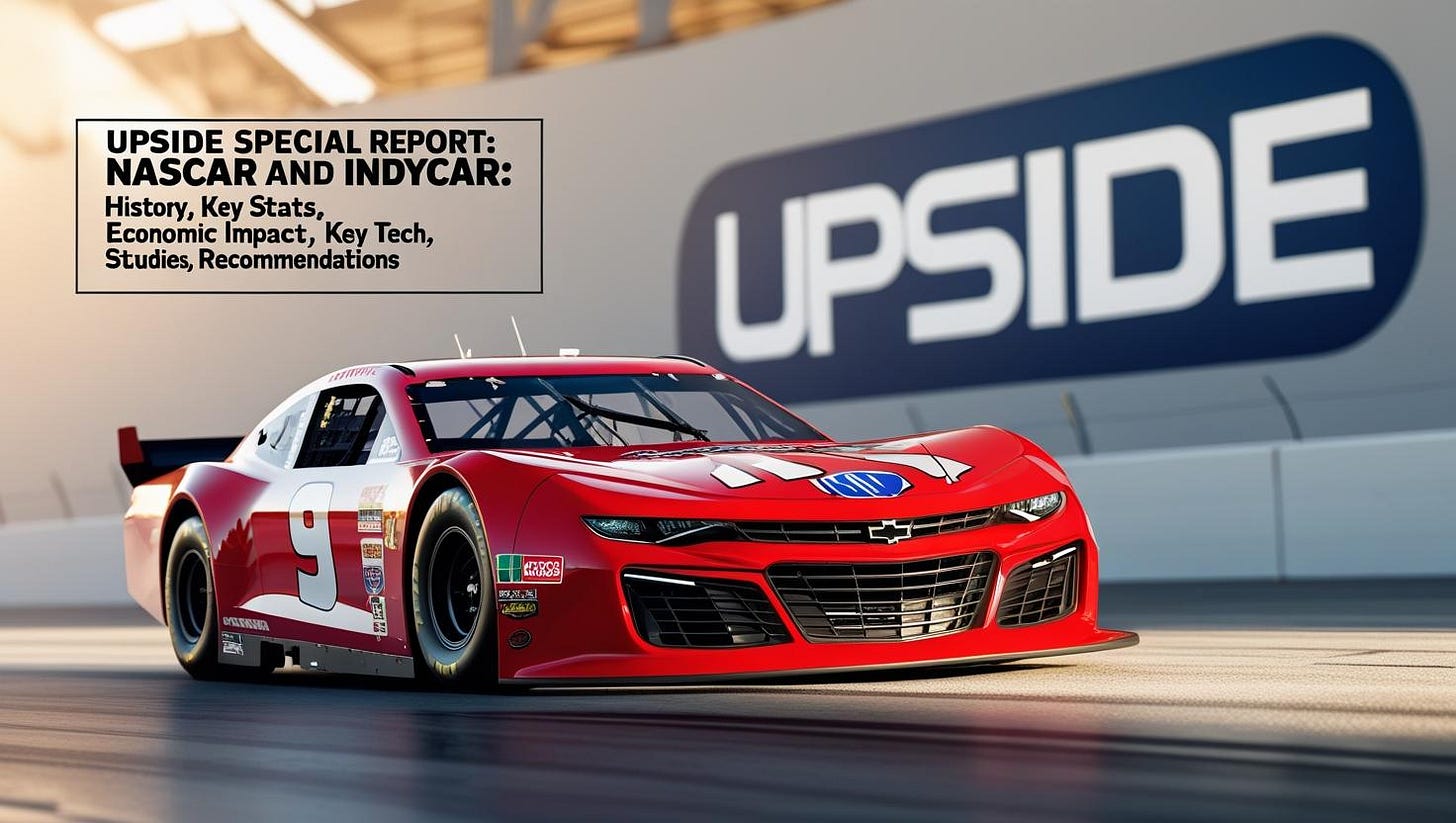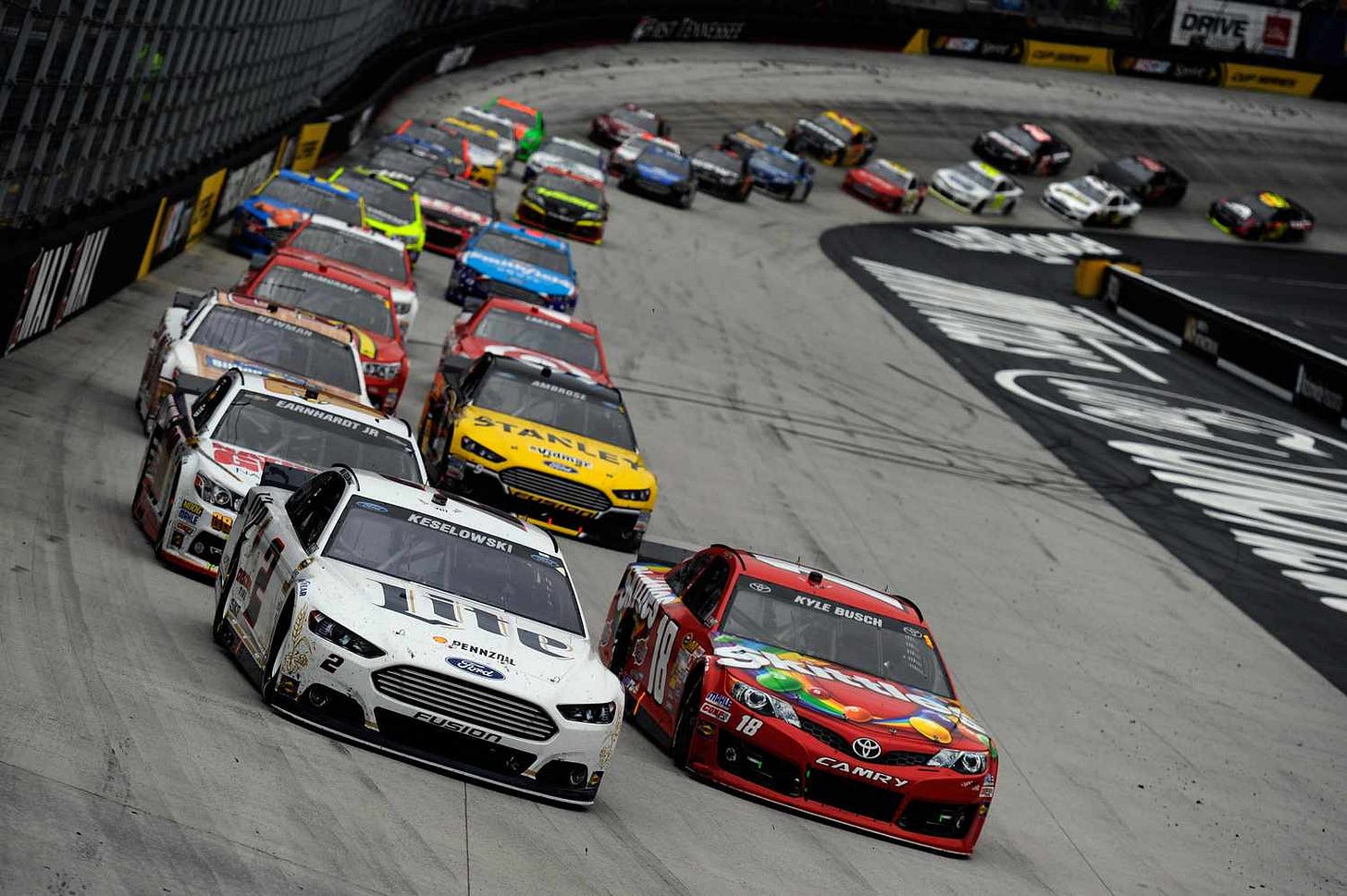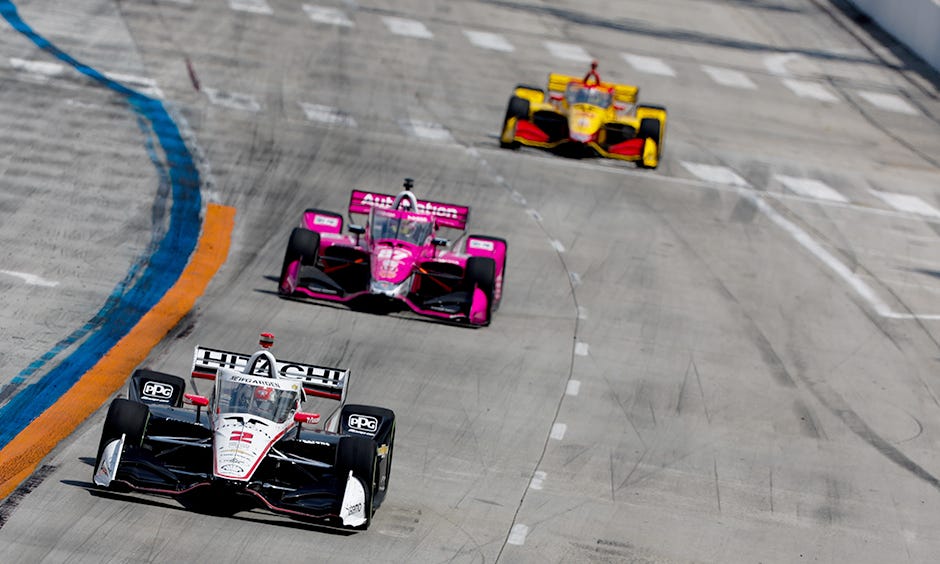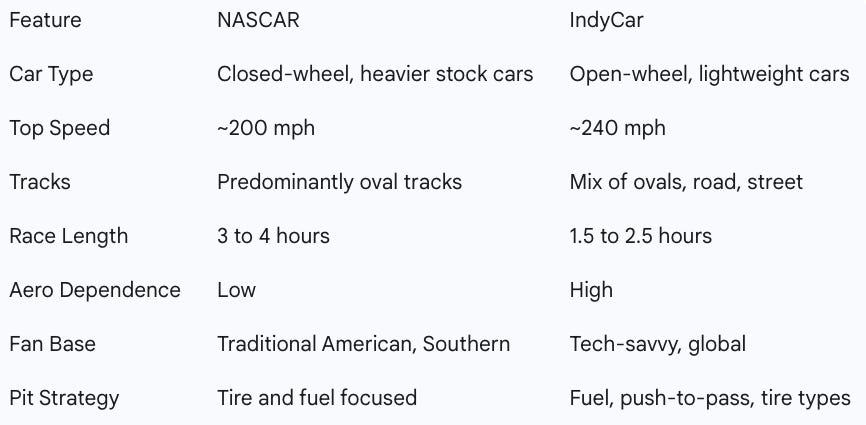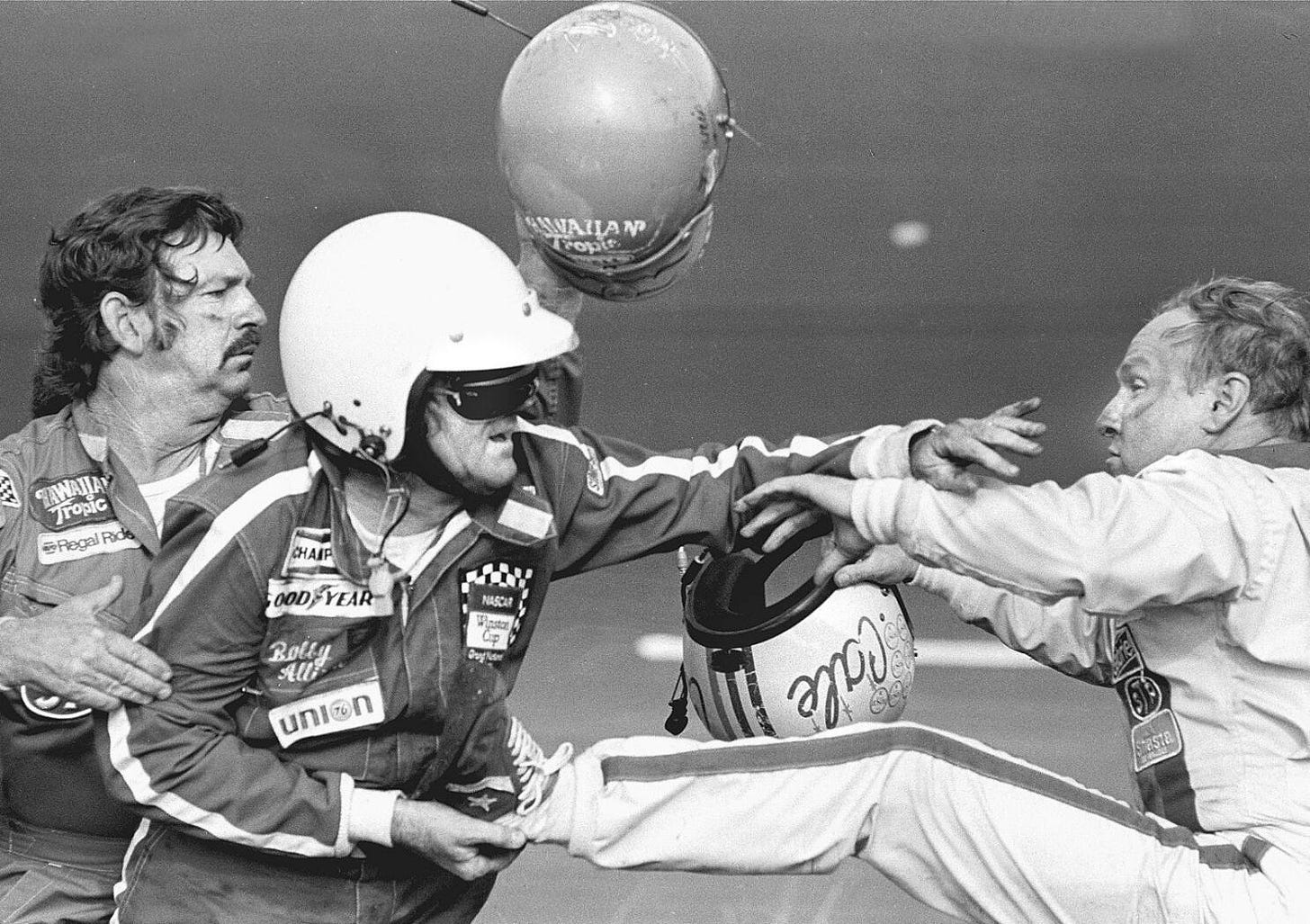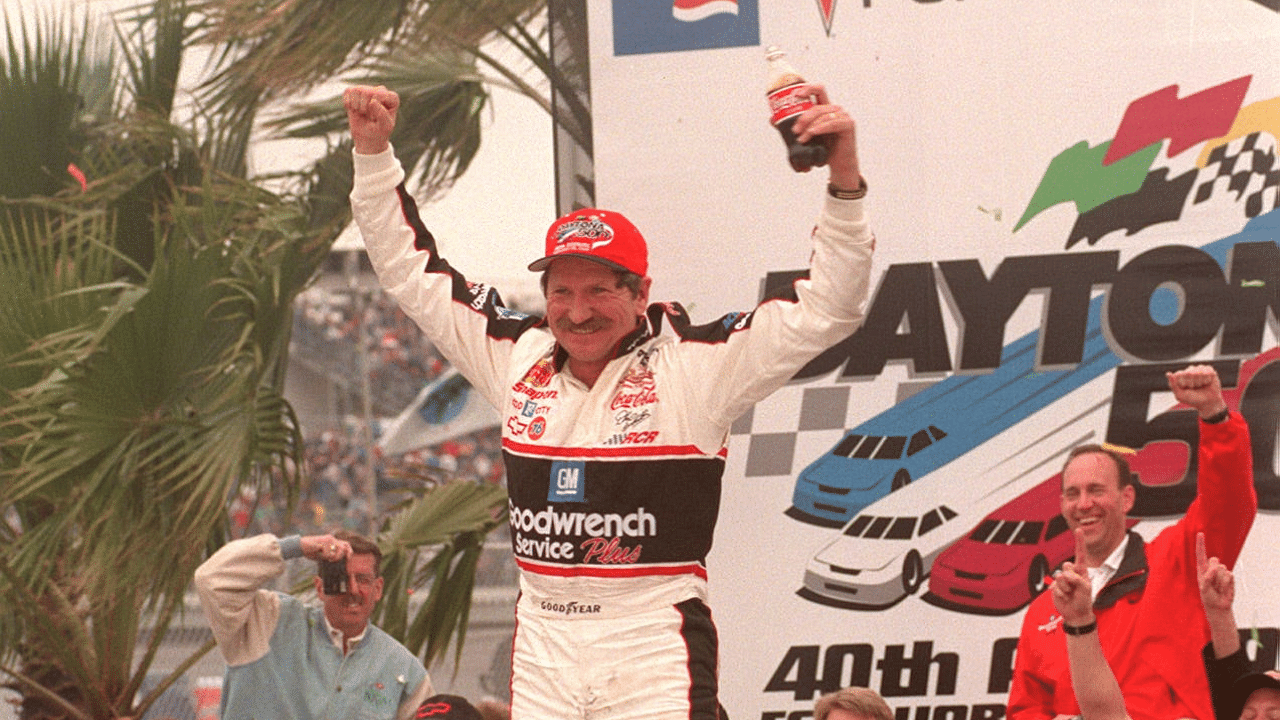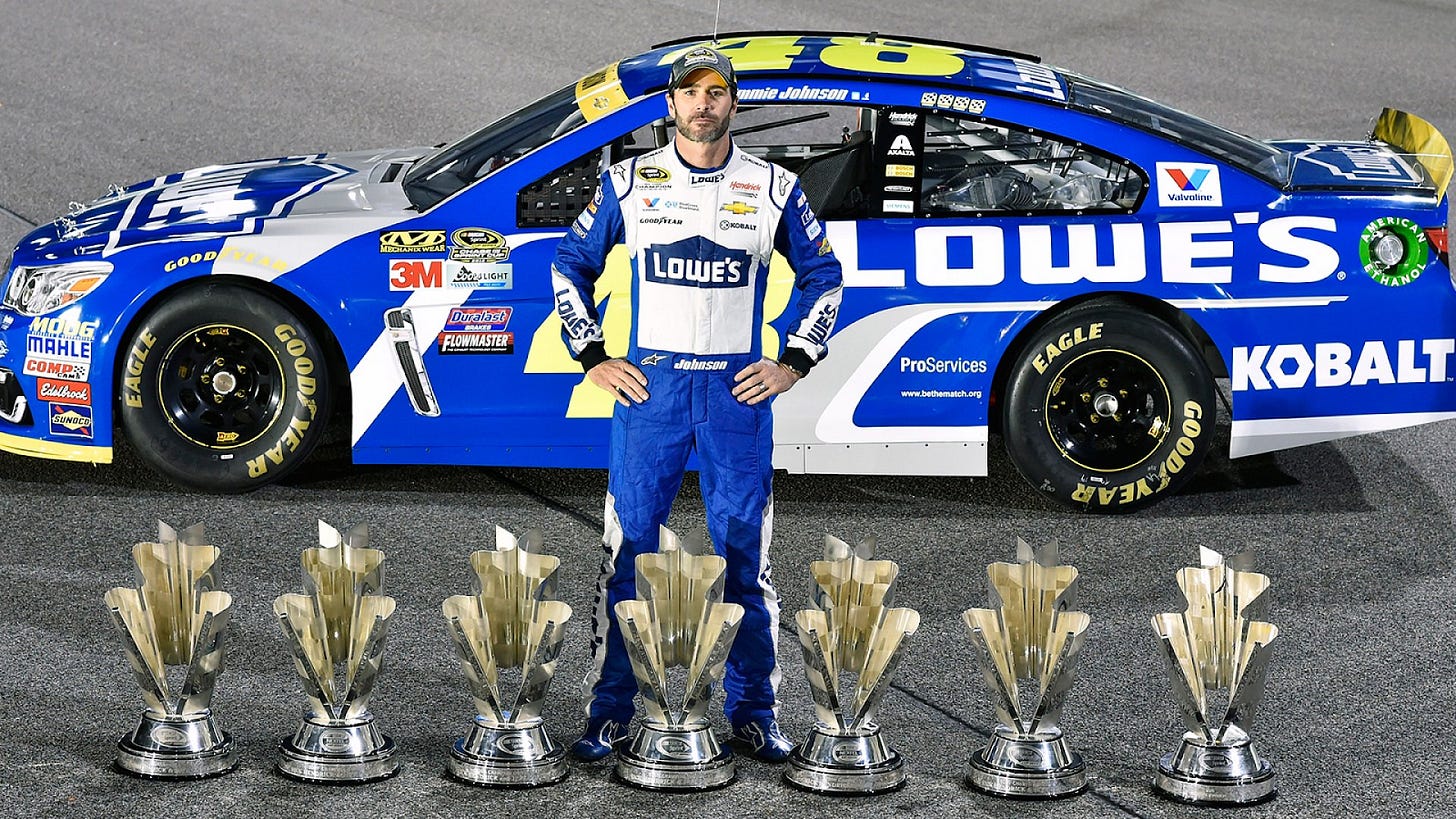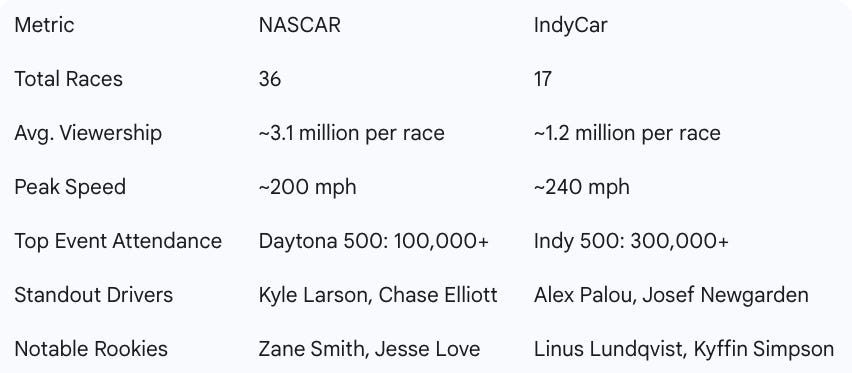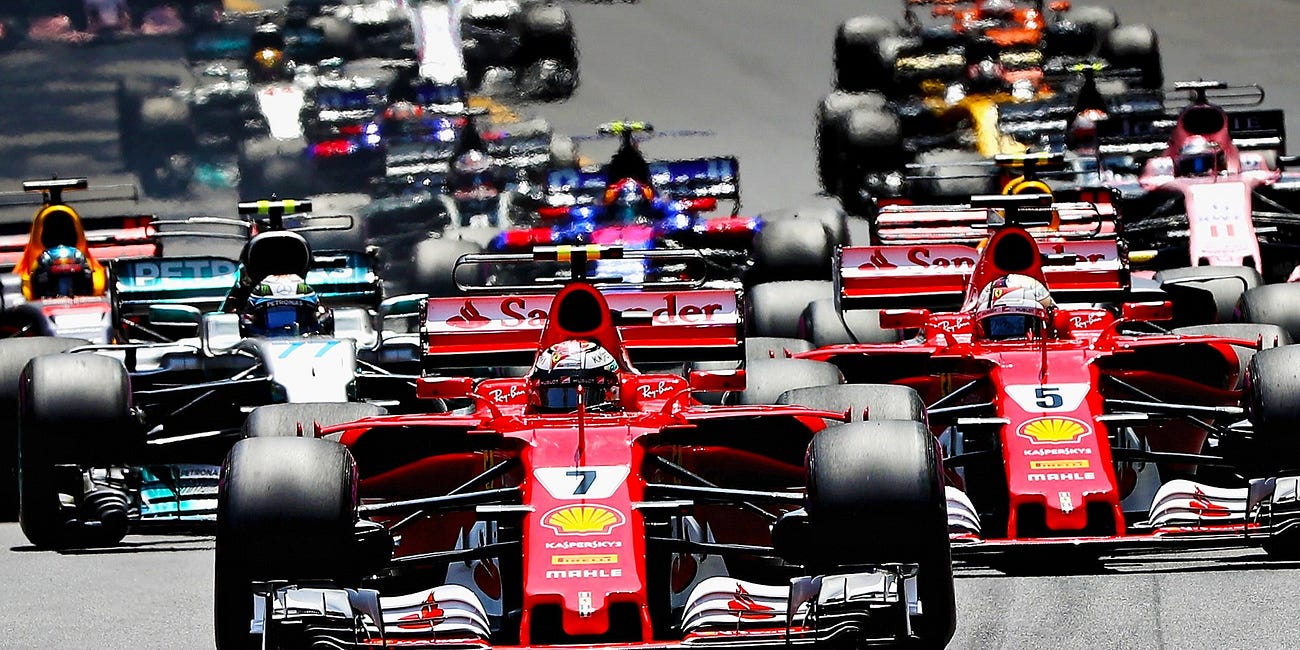🏁 Upside Special Report: NASCAR and IndyCar: History, Key Stats, Studies, Tech, Recommendations to Startups
As the 2025 seasons of NASCAR and IndyCar come to a close, motorsports fans are once again captivated by the high-speed drama, strategic brilliance, and engineering marvels that make each series unique. Though both are top-tier American motorsports leagues, they operate in largely different ecosystems—with divergent cultures, technologies, and fan bases. This report delves into their rich histories, compares their defining features, highlights major 2025 trends, the main tech used, the key stats and studies, and offers actionable insights for startups looking to enter this fast-paced industry.
History of NASCAR and IndyCar
NASCAR
The National Association for Stock Car Auto Racing (NASCAR) was founded in 1948 by Bill France Sr. Originally inspired by the Prohibition-era bootleggers who modified stock cars for speed and concealment, NASCAR grew into a national spectacle. Its early years were centered around dirt tracks in the South, evolving into a full-fledged national series with iconic venues like Daytona, Talladega, and Bristol. Over the years, stars such as Richard Petty, Dale Earnhardt, Jeff Gordon, and Jimmie Johnson have become legends, elevating NASCAR to one of America's favorite sports.
IndyCar
IndyCar's legacy begins with the Indianapolis 500, first held in 1911. While the modern IndyCar Series was officially formed in 1996, the sport has gone through multiple organizational shifts—most notably the CART-IRL split and eventual reunification in 2008. IndyCar combines road courses, street circuits, and ovals, offering a blend of technical prowess and speed. Its international appeal is bolstered by diverse driver lineups and a focus on advanced vehicle dynamics.
Main Differences Between NASCAR and IndyCar
Iconic Moments in NASCAR and IndyCar History
NASCAR Highlights
1979 Daytona 500: A televised fight between Cale Yarborough and the Allison brothers brought national attention.
Dale Earnhardt's 1998 Daytona Win: An emotional, long-awaited victory after 20 attempts.
Jimmie Johnson's Seven Titles: A modern dynasty matching the legendary Richard Petty and Dale Earnhardt.
IndyCar Highlights
Dan Wheldon’s 2011 Indy 500 Victory: A last-lap pass in a dramatic finish, months before his tragic death.
Alex Zanardi’s Corkscrew Pass (1998): One of the most daring overtakes in motorsport history.
Helio Castroneves' 4th Indy 500 Win (2021): A historic moment at age 46, joining the elite four-time winners club.
Key Stats About NASCAR and IndyCar (2025 Season)
The Economic Impact of NASCAR and IndyCar
NASCAR
Contributes over $5 billion annually to the U.S. economy.
Sponsorship-heavy business model with companies like Monster Energy, Coca-Cola, and Xfinity.
Significant impact on Southern U.S. tourism, especially in states like North Carolina and Florida.
IndyCar
Generates approximately $1.2 billion annually, with a leaner commercial model.
The Indianapolis 500 alone brings in $400 million+ in economic activity for Indiana.
Supported by global brands such as NTT Data, Honda, and Firestone.
The Importance of Technologies in NASCAR and IndyCar
NASCAR
Next Gen car introduced carbon fiber bodies, independent rear suspension, and improved safety.
Emphasis on data analytics for pit stop timing and in-race decision making.
Use of iRacing platforms and simulation tools to train drivers and engage fans.
IndyCar
Heavy integration of telemetry, aerodynamics, and real-time data transmission.
Push-to-pass system allows for short bursts of horsepower.
Experimenting with hybrid power units and sustainability technologies.
📡 Performance Technology in NASCAR and IndyCar
Modern motorsports have embraced cutting-edge performance technology to enhance driver safety, optimize performance, and reduce injuries. Both NASCAR and IndyCar are at the forefront of adopting tools ranging from wearables and biometric sensors to AI-driven analytics and rehabilitation platforms. Here’s how each sport is evolving:
1. Wearables and Biometric Monitoring
Drivers in both series now wear sensors that track vital signs and physiological markers in real time, such as:
Heart rate variability (HRV)
Core body temperature
Respiration rate
G-force exposure
🔹 IndyCar Example: Many IndyCar drivers wear biometric fireproof undershirts (developed in partnership with companies like Embr Labs, WHOOP, and NASA-derived tech) that help teams monitor driver fatigue, overheating, and cardiovascular strain during long races.
🔹 NTT Story (May 2019) example – Describes early biometric testing using hitoe® smart fabric undershirts in the IndyCar Series—including heart rate, ECG waveforms, and muscle contractions alignment with vehicle dynamics NTT.
🔹 NASCAR Example: In NASCAR, WHOOP straps and similar wrist-based wearables are used by some drivers to track recovery, strain, and sleep patterns in preparation for grueling races.
“NASCAR Drivers Had Real‑Time Whoop Data Integrated Into NBC’s Broadcast” – several NASCAR drivers (including Denny Hamlin and Daniel Suárez) wore Whoop straps during the 2021 Coke Zero Sugar 400 at Daytona, and their heart rate, calories burned, and strain scores were displayed on NBC’s broadcast (Source here)
2. Rehabilitation and Recovery Tech
Unlike athletes in traditional sports, race car drivers face chronic neck, spine, and shoulder strain due to prolonged vibration and G-forces. Rehab tech has adapted accordingly:
Neck training systems (e.g., Iron Neck, Halo Sport) are now widely used in NASCAR and IndyCar garages.
Pneumatic resistance systems (e.g., Proteus Motion) help drivers mimic cockpit-specific movements while training for force application and rotational control.
Neurofeedback and VR platforms assist in cognitive rehab and post-crash recovery.
3. Telemetry, AI, and Predictive Analytics
Race teams now gather millions of data points per race. AI and ML models are used to:
Predict driver fatigue or crash likelihood
Monitor car vibrations affecting driver neuromuscular fatigue
Model optimal hydration/fuel consumption vs. physiological stress
Detect early signs of driver cognitive decline during long stints
🔹 NASCAR Example: Teams partner with firms like Dell Technologies, AWS, and NVIDIA to analyze in-car telemetry along with wearable driver data, creating AI models that guide decisions on pit stops and in-race driver coaching (Source here).
🔹 IndyCar Example: NTT Data provides real-time data analysis and augmented driver telemetry, helping engineers synchronize car dynamics with biometric trends, especially during high-stress laps.
4. Simulators and Virtual Reality (VR)
NASCAR and IndyCar use advanced racing simulators for:
Cognitive load training
Track visualization and reaction drills
Physiological stress adaptation
Many teams now integrate SimCraft, iRacing Pro, and VR telemetry overlays into training. Some simulators even offer biofeedback integration, giving real-time insights on how heart rate and reaction speed change per track condition.
🔧 Future Trends
Adoption of digital twins for driver-vehicle modeling
Wider use of non-invasive blood diagnostics (like biometric patches) to monitor inflammation post-race
Integration of AI-generated training plans tied to cognitive readiness, not just physical performance
📚 Key Studies and Research References
1. Physiological Conditioning in Motorsports Athletes
Title: Physiological Demands of Motorsport Drivers: A Simulated-Driving Experiment
A simulated‐driving experiment showing professional racers have significantly faster reaction times (Cohen’s d ≈ –1.43, p = 0.004), with large cognitive advantages versus non‑drivers (Source here).
This thesis also discusses demands on core temperature, heart rate, and breathing, and the value of wearable tech and neurofeedback in driver training (Source here).
Summary: Found that professional drivers have significantly faster reaction times and better thermal regulation under stress.
2. Wake Forest / NASCAR Mouthpiece Sensor Study
Title: Measuring Impacts: One Race at a Time
Researchers (Joel Stitzel, PhD, et al.) introduced instrumented mouthpiece sensors for head impact monitoring in NASCAR Cup Series races starting in 2023, offering new insights into crash trauma and safety improvements (Source here).
Summary: Describes the use of biometric mouthpieces to measure crash G-forces in NASCAR.
3. Heart Rate Variability (HRV) for Drowsiness Detection
Title: HRV-Based Drowsiness Detection Using Machine Learning and PPG Wearables
A 2025 PubMed‑indexed study describes an HRV‑based system using PPG wearables and machine learning (random forest, SVM‑RBF) achieving ~86% accuracy in real‑world driver drowsiness detection (Source here)
Summary: High accuracy model (86%) for fatigue detection in drivers using heart rate variability from wearable devices.
4. Kinematic Clustering & Machine Learning for TBI Estimation
Zhan et al. used ML to cluster head‐impact types (including from car crashes/NASCAR) and improve injury prediction (R² up to ~0.9 vs. 0.7 baseline) by tailoring regression by impact subtype (Source here).
5. AI in Sports Injury Prediction & Performance
Title: Learning to Predict Brain Trauma from Clusters of Impact Kinematics (Zhan et al.)
Reviews of AI/ML applications in sports performance, injury risk prediction, and personalized training—including frameworks relevant to motorsports and rehabilitation settings (Source here)
Summary: Used kinematic clustering and machine learning to improve predictions of traumatic brain injuries, applicable to motorsports.
6. Simulation Telemetry & AI Prediction in Racing
Title: AI-enabled Prediction of Sim Racing Performance Using Telemetry Data
A recent study applied machine learning to sim-racing telemetry to isolate key performance indicators (e.g., braking behavior) that strongly influence lap time improvements (Source here).
Summary: Demonstrates how AI can predict driver performance using telemetry—transferable to IndyCar and NASCAR.
Recommendations for Startups Trying to Break into NASCAR and IndyCar
Find a Performance Niche: Focus on technologies that optimize pit stops, driver recovery, or in-race strategy.
Leverage Esports: Create fan engagement tools or simulators integrated with platforms like iRacing.
Prioritize Sustainability: Develop solutions that support biofuels, tire recycling, or hybrid system integrations.
Partner with Feeder Series: Test and refine your products in ARCA (NASCAR) or Indy NXT (IndyCar).
Offer Telemetry and Biometric Services: Teams increasingly demand in-race physiological and mechanical analytics.
Think Broadcast-Friendly: Build tools that integrate live race data with real-time storytelling for fans.
Conclusion
The 2025 NASCAR and IndyCar seasons have demonstrated the evolving yet enduring appeal of American motorsports. NASCAR continues to dominate traditional racing markets with its heritage and mass appeal, while IndyCar impresses with its global diversity and technical excellence. For startups and innovators, both leagues present exciting but different opportunities. With the right blend of domain knowledge, product-market fit, and strategic partnerships, new entrants can leave their mark in an industry where speed, data, and passion rule the track.
You may also like:
🏎️ The F1 tech market
Formula 1 (F1) is one of the most popular sports in the world, with 550M F1 fans tunning in every year to watch F1 races. It is also one of the most tech savvy sports on the planet.

